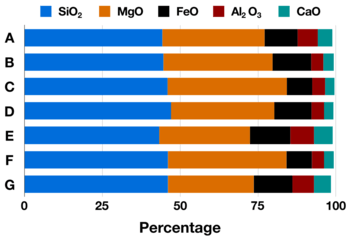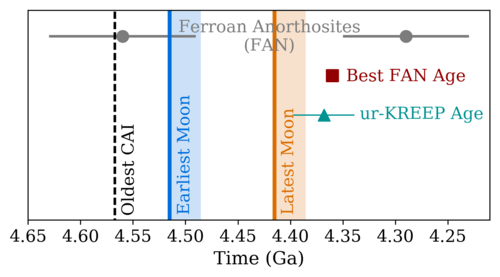Lunar magma ocean
The Lunar Magma Ocean (LMO) is the layer of molten rock that is theorized to have been present on the surface of the Moon. The Lunar Magma Ocean was likely present on the Moon from the time of the Moon's formation (about 4.5 or 4.4 billion years ago[1]) to tens or hundreds of millions years after that time. It is a thermodynamic consequence of the Moon's relatively rapid formation in the aftermath of a giant impact between the proto-Earth and another planetary body. As the Moon accreted from the debris from the giant impact, gravitational potential energy was converted to thermal energy. Due to the rapid accretion of the Moon (in about a month to a year),[2][3][4] thermal energy was trapped since it did not have sufficient time to thermally radiate away energy through the lunar surface. The subsequent thermochemical evolution of the Lunar Magma Ocean explains the Moon's largely anorthositic crust, europium anomaly, and KREEP material.

The Lunar Magma Ocean was initially proposed by two groups in 1970 after they analyzed anorthositic rock fragments found in the Apollo 11 sample collection.[5][6] Wood et al. used fragments of bulk sample 10085 for their analyses.[7] Ferroan anorthosite rocks found during the Apollo program are composed primarily (over 90%) of the mineral plagioclase.[8] More specifically, ferroan anorthosite rocks found on the Moon consist of the calcium (Ca) end-member of plagioclase (i.e., anorthite).[9] This suggests that at least upper layers of the Moon were molten in the past due to the purity of lunar anorthosites and the fact that anorthite generally has a high crystallization temperature.[10]
.jpg)
Initial state

There are three important parameters when considering the initial state of the Lunar Magma Ocean: chemical composition, depth, and temperature. These three parameters largely determine the thermochemical evolution. For the Lunar Magma Ocean, there are uncertainties associated with each of these initial conditions. A typical initial chemical composition is 47.1% SiO2, 33.1% MgO, 12.0% FeO, 4.0% Al2O3, and 3.0% CaO (with minor contributions from other molecules), along with an initial depth of 1000 km and a basal temperature of 1900 K.[16]
Initial chemical composition and depth
Initial chemical composition of the Lunar Magma Ocean is estimated based on the chemistry of lunar samples, along with the chemical composition and thickness of the current lunar crust. For computer modeling purposes, the initial chemical composition is typically defined by weight percent based on a system of basic molecules such as SiO2, MgO, FeO, Al2O3, and CaO. Seven example initial chemical compositions of the Lunar Magma Ocean from the literature are shown in the figure to the right. These compositions are generally similar to the composition of the Earth's mantle with the main difference being some (e.g., Taylor Whole Moon[11]) or no enhancement (e.g., Lunar Primitive Upper Mantle[15]) of refractory elements.
The estimated initial depth of the Lunar Magma Ocean varies from 100 km to the radius of the Moon.[20][16][21][22]
Crystallization sequence
Exact sequence of minerals that crystallize out of the Lunar Magma Ocean depends on the initial state of the Lunar Magma Ocean (viz. chemical composition, depth, and temperature). Following the idealized Bowen's Reaction Series, olivine is generally expected to crystallize first, followed by orthopyroxene. These minerals are denser than the surrounding magma and thus sink towards the bottom of the Lunar Magma Ocean. As such, the Lunar Magma Ocean is initially expected to solidify from the bottom up. After about 80% of the Lunar Magma Ocean has crystallized, the mineral plagioclase crystallizes along with other minerals. Rocks that are primarily made of plagioclase (i.e., anorthosite) form and float towards the surface of the Moon making the primordial crust of the Moon.
Duration
The Lunar Magma Ocean may have lasted tens to hundreds of millions of years after Moon formation. The Moon is estimated to have formed between 52 and 152 million years after calcium-aluminum-rich inclusions (CAIs),[1] which being the oldest solids in the Solar System serve as a proxy for the age of the Solar System. This in turn leaves the exact formation time of the Lunar Magma Ocean somewhat uncertain. On the other hand, the end point may be indicated by the age of ferroan anorthosite (FAN) sample 60025 (4.360±0.003 Ga) and the estimated age of ur-KREEP (4.368±0.029 Ga).[23] If the Moon formed early (i.e., 52 million years after Solar System formation) and both the ferroan anorthosite sample 60025 and the estimated age of ur-KREEP indicate when the Lunar Magma Ocean fully crystallized, then the Lunar Magma Ocean would have lasted for about 155 million years. In that case, computer models show that one or more heat sources (such as tidal heating) are required to prolong crystallization of the Lunar Magma Ocean.[24][25] On the other hand, if the Moon formed late (i.e., 152 million years after Solar System formation) then again using the ferroan anorthosite sample 60025's age and the estimated age of ur-KREEP, the Lunar Magma Ocean lasted for about 55 million years. That would mean that the Lunar Magma Ocean was not prolonged by one or more additional heat sources.

In the past, the age difference between the oldest and youngest ferroan anorthosite samples were used to determine the duration of the Lunar Magma Ocean. This was problematic due to the large errors of sample ages and due to some sample ages being reset by impacts. For instance, the oldest ferroan anorthosite sample is 67016 with a Sm-Nd age of 4.56±0.07 Ga[26] and the youngest is 62236 with a Sm-Nd age of 4.29±0.06 Ga.[27] The difference between these ages is 270 million years. This would again mean that the Lunar Magma Ocean had an additional heat source, such as tidal heating.[24]
Refuting evidence
One of the alternative models to the Lunar Magma Ocean model is the Serial Magmatism model.[28][29]
References
- Touboul, Mathieu; Kleine, Thorsten; Bourdon, Bernard; Palme, Herbert; Wieler, Rainer (February 2009). "Tungsten isotopes in ferroan anorthosites: Implications for the age of the Moon and lifetime of its magma ocean". Icarus. 199 (2): 245–249. doi:10.1016/j.icarus.2008.11.018. ISSN 0019-1035.
- Ida, Shigeru; Canup, Robin M.; Stewart, Glen R. (September 1997). "Lunar accretion from an impact-generated disk". Nature. 389 (6649): 353–357. doi:10.1038/38669. ISSN 0028-0836.
- Kokubo, E (December 2000). "Evolution of a Circumterrestrial Disk and Formation of a Single Moon". Icarus. 148 (2): 419–436. doi:10.1006/icar.2000.6496.
- Takeda, Takaaki; Ida, Shigeru (2001-10-10). "Angular Momentum Transfer in a Protolunar Disk". The Astrophysical Journal. 560 (1): 514–533. doi:10.1086/322406. ISSN 0004-637X.
- Smith, J. V.; Anderson, A. T.; Newton, R. C.; Olsen, E. J.; Wyllie, P. J. (July 1970). "A Petrologic Model for the Moon Based on Petrogenesis, Experimental Petrology, and Physical Properties". The Journal of Geology. 78 (4): 381–405. doi:10.1086/627537. ISSN 0022-1376.
- Wood, J. A.; Dickey, J. S.; Marvin, U. B.; Powell, B. N. (1970-01-30). "Lunar Anorthosites". Science. 167 (3918): 602–604. doi:10.1126/science.167.3918.602. ISSN 0036-8075.
- "Apollo Sample Description". curator.jsc.nasa.gov. Retrieved 2019-09-29.
- "PSRD: The Oldest Moon Rocks". www.psrd.hawaii.edu. Retrieved 2019-09-27.
- Dowty, Eric; Prinz, Martin; Keil, Klaus (November 1974). "Ferroan anorthosite: A widespread and distinctive lunar rock type". Earth and Planetary Science Letters. 24 (1): 15–25. doi:10.1016/0012-821x(74)90003-x. ISSN 0012-821X.
- Reynolds, Stephen J. (2015-01-12). Exploring geology. Shaw, Cynthia C. (Fourth ed.). New York, NY. p. 123. ISBN 9780078022920. OCLC 892304874.
- Taylor, Stuart (1982). Planetary Science: A Lunar Perspective. Lunar and Planetary Institute.
- Elardo, Stephen M.; Draper, David S.; Shearer, Charles K. (June 2011). "Lunar Magma Ocean crystallization revisited: Bulk composition, early cumulate mineralogy, and the source regions of the highlands Mg-suite". Geochimica et Cosmochimica Acta. 75 (11): 3024–3045. doi:10.1016/j.gca.2011.02.033. ISSN 0016-7037.
- O'Neill, H.St.C (April 1991). "The origin of the moon and the early history of the earth—A chemical model. Part 1: The moon". Geochimica et Cosmochimica Acta. 55 (4): 1135–1157. doi:10.1016/0016-7037(91)90168-5. ISSN 0016-7037.
- Schwinger, S.; Breuer, D. (2018-12-01). "Modeling the Thermochemical Evolution of the Lunar Magma Ocean using Igneous Crystallization Programs". AGU Fall Meeting Abstracts. 31: P31G–3778. Bibcode:2018AGUFM.P31G3778S.
- Longhi, John (December 2006). "Petrogenesis of picritic mare magmas: Constraints on the extent of early lunar differentiation". Geochimica et Cosmochimica Acta. 70 (24): 5919–5934. doi:10.1016/j.gca.2006.09.023. ISSN 0016-7037.
- Elkins-Tanton, Linda T.; Burgess, Seth; Yin, Qing-Zhu (April 2011). "The lunar magma ocean: Reconciling the solidification process with lunar petrology and geochronology". Earth and Planetary Science Letters. 304 (3–4): 326–336. doi:10.1016/j.epsl.2011.02.004. ISSN 0012-821X.
- Morgan, John W.; Hertogen, Jan; Anders, Edward (June 1978). "The moon: Composition determined by nebular processes". The Moon and the Planets. 18 (4): 465–478. doi:10.1007/bf00897296. ISSN 0165-0807.
- Ringwood, A. E.; Kesson, S. E. (1976-04-01). "A dynamic model for mare basalt petrogenesis". Lunar and Planetary Science Conference Proceedings. 7: 1697–1722. Bibcode:1976LPSC....7.1697R.
- Warren, Paul H. (1986-03-30). "Anorthosite assimilation and the origin of the Mg/Fe-related bimodality of pristine moon rocks: Support for the magmasphere hypothesis". Journal of Geophysical Research: Solid Earth. 91 (B4): 331–343. doi:10.1029/jb091ib04p0d331. ISSN 0148-0227.
- Andrews-Hanna, J. C.; Asmar, S. W.; Head, J. W.; Kiefer, W. S.; Konopliv, A. S.; Lemoine, F. G.; Matsuyama, I.; Mazarico, E.; McGovern, P. J. (2012-12-05). "Ancient Igneous Intrusions and Early Expansion of the Moon Revealed by GRAIL Gravity Gradiometry". Science. 339 (6120): 675–678. doi:10.1126/science.1231753. ISSN 0036-8075.
- Rapp, J. F.; Draper, D. S. (2018-04-16). "Fractional crystallization of the lunar magma ocean: Updating the dominant paradigm". Meteoritics & Planetary Science. 53 (7): 1432–1455. doi:10.1111/maps.13086. ISSN 1086-9379.
- Solomon, S. C.; Chaiken, J. (1976-04-01). "Thermal expansion and thermal stress in the moon and terrestrial planets - Clues to early thermal history". Lunar and Planetary Science Conference Proceedings. 7: 3229–3243. Bibcode:1976LPSC....7.3229S.
- Borg, Lars E.; Gaffney, Amy M.; Shearer, Charles K. (2015). "A review of lunar chronology revealing a preponderance of 4.34–4.37 Ga ages". Meteoritics & Planetary Science. 50 (4): 715–732. doi:10.1111/maps.12373. ISSN 1945-5100.
- Chen, Erinna M.A.; Nimmo, Francis (September 2016). "Tidal dissipation in the lunar magma ocean and its effect on the early evolution of the Earth–Moon system". Icarus. 275: 132–142. doi:10.1016/j.icarus.2016.04.012. ISSN 0019-1035.
- Perera, Viranga; Jackson, Alan P.; Elkins-Tanton, Linda T.; Asphaug, Erik (May 2018). "Effect of Reimpacting Debris on the Solidification of the Lunar Magma Ocean". Journal of Geophysical Research: Planets. 123 (5): 1168–1191. doi:10.1029/2017je005512. hdl:10150/628510. ISSN 2169-9097.
- Alibert, Chantal; Norman, Marc D.; McCulloch, Malcolm T. (July 1994). "An ancient Sm-Nd age for a ferroan noritic anorthosite clast from lunar breccia 67016". Geochimica et Cosmochimica Acta. 58 (13): 2921–2926. doi:10.1016/0016-7037(94)90125-2. ISSN 0016-7037.
- Borg, Lars; Norman, Marc; Nyquist, Larry; Bogard, Don; Snyder, Greg; Taylor, Larry; Lindstrom, Marilyn (October 1999). "Isotopic studies of ferroan anorthosite 62236: a young lunar crustal rock from a light rare-earth-element-depleted source". Geochimica et Cosmochimica Acta. 63 (17): 2679–2691. doi:10.1016/s0016-7037(99)00130-1. ISSN 0016-7037.
- Gross, J.; Treiman, A. H.; Mercer, C. N. M. (March 2012). "Sinking the Lunar Magma Ocean: New Evidence from Meteorites and the Return of Serial Magmatism". Lunar and Planetary Science Conference: 2306.
- Gross, Juliane; Treiman, Allan H.; Mercer, Celestine N. (February 2014). "Lunar feldspathic meteorites: Constraints on the geology of the lunar highlands, and the origin of the lunar crust". Earth and Planetary Science Letters. 388: 318–328. doi:10.1016/j.epsl.2013.12.006. ISSN 0012-821X.
